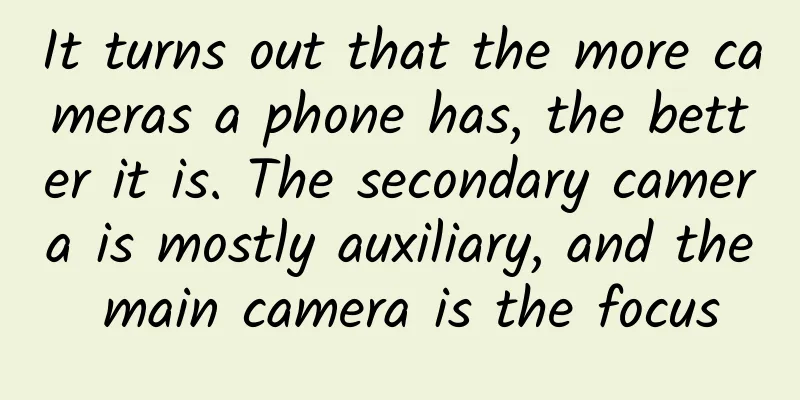It turns out that the more cameras a phone has, the better it is. The secondary camera is mostly auxiliary, and the main camera is the focus

|
Nowadays, smartphones often have several cameras. Rear triple/quadruple cameras are very popular, and some models even have five rear cameras. In the minds of many digital novices, the more cameras a phone has, the better its photo performance will be. But is this really the case? I can tell you responsibly: the main camera is the key point, and the secondary camera is just the icing on the cake! How important is the main camera? Daily photography depends entirely on it, and the sensor is of paramount importance. What is a main camera lens? Simply put, it is the lens that is mainly responsible for taking pictures. At first glance, it sounds like nonsense, but if you think about it carefully, since the main camera is responsible for daily photography, its importance is naturally far superior to other secondary cameras. The most important component in the main camera is the CMOS sensor. The Sony IMX700, IMX600, IMX686, Samsung GW1, etc. that we often mention refer to the models of CMOS sensors. As the saying goes, "a bigger sensor can kill you", the size of the CMOS sensor is very important and determines the amount of light entering. The larger its size, the higher the degree of scene restoration, the stronger the color control, and the more delicate the image. It is worth noting that this has no direct connection with the size of the pixel value, and the pixel value cannot determine the actual photo effect. If you like taking pictures, when buying a mobile phone, be sure to pay attention to its main camera and CMOS sensor model, rather than just looking at the pixel value. What is the role of the secondary camera? Each lens has its own division of labor, which affects the number of photo functions. Multi-camera phones are popular now, that is, a combination of one main camera + multiple secondary cameras (Huawei's flagship phones often use a combination of dual main cameras + multiple secondary cameras). What are the uses of so many secondary cameras? Simply put: the more secondary cameras a phone has, the more camera functions it has. For example, a telephoto lens will bring excellent long-range zoom capabilities, and an ultra-wide-angle lens can effectively expand the actual shooting frame, allowing the photo to accommodate more scenery. If the main camera is well configured and the image optimization algorithm is in place, then you can achieve good results in daily photography. If the secondary camera has many functions, then the way of taking photos will be richer, whether it is a distant view or a close view, you can easily control it, and experienced photographers will take more exciting and creative pictures. But for most ordinary users, the secondary camera is not used frequently, and its importance is naturally not as good as the main camera. Do you want to know about the secondary camera? These four cameras are not the same as those four cameras. Newbies are easily fooled! As mentioned earlier, the role of the secondary camera is to provide more photo functions. Different lenses have different functions, so the manufacturing costs are naturally different. Many mobile phone manufacturers have no sincerity and always blindly pursue marketing gimmicks, often using useless lenses to make up the numbers. Typical secondary cameras include: macro lens, black and white lens, portrait lens, etc. The flagship phone is also a quad-camera phone. It uses dual main cameras + telephoto + ultra-wide-angle lenses. It not only ensures the diversity of functions, but also brings users a SLR-level photography experience. The insincere quad-camera phone is equipped with a low-spec main camera + blur + macro + portrait lens, which has poor actual shooting effects and a mess of functions with extremely low practicality. The difference between them is obvious at a glance! To sum up, to discuss whether a mobile phone's photography performance is strong or not, we must first consider the hardware specifications of the main camera. The secondary camera can only be said to be a side dish, it is better to have it, but it doesn't matter if it is not. Periscope telephoto lenses and ultra-wide-angle lenses are the "hard currency" in secondary cameras, and other types of lenses are more or less used to make up the numbers. Everyone must keep their eyes open when buying a mobile phone! |
<<: Android adds five new features: map enhancements, Gboard Emoji combinations, and more
>>: Detailed usage of Motion Editor in Android Studio
Recommend
The bridge deck of a highway in Hubei overturned. From a professional perspective, here is a guide: Are single-column pier bridges safe?
At about 3:36 pm on December 18, a rollover accid...
2017 Big Data Festival is coming in October, iResearch A10 Summit will open on the 27th
As a major event in the field of big data in Chin...
Netgear has launched a new product line, the Orbi, which can split into two parts. Will it attract you if you don’t have a house?
If someone tells you, "My router is NETGEAR....
How does a brand do marketing?
Let’s first look at two interesting marketing hyp...
With current human science and technology, can we completely destroy the earth?
This article is based on answering similar questi...
Today, it was officially unveiled! So beautiful!
This morning South China National Botanical Garde...
Google hires macOS veteran to develop Fuchsia OS: accelerate replacement of Android/Chrome OS
As early as 2016, clues that Google was secretly ...
How much does it cost to join an attendance app in Bayannur?
How much does it cost to join the Bayannur Attend...
Why is it snow "flowers" instead of snow "grass" or snow "trees"?
Snow is a pure white gift from nature to people. ...
Data Operations: How to do data analysis for market growth!
Written at the beginning: This article is transla...
“White noise” helps you sleep, is it science or hoax?
Open the video website, enter "noise", ...
Google Maps app update: COVID-19 reminders added to Android and iOS versions
Although the COVID-19 epidemic caused by the new ...
Are there any stomach aches that you think are harmless but are actually very dangerous?
Appendix: The content of this article is for refe...









